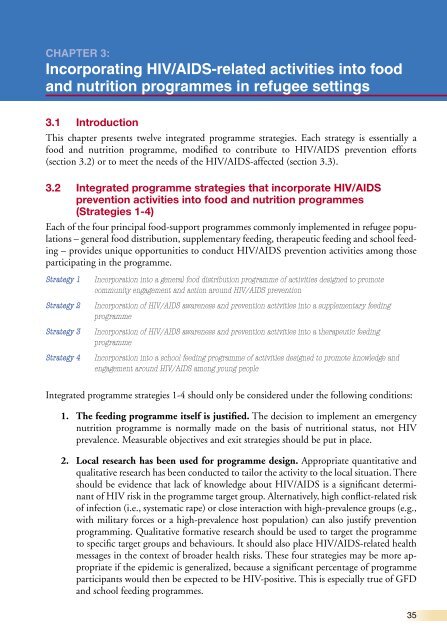Integration of HIV/AIDS activities with food and nutrition support in ...
Integration of HIV/AIDS activities with food and nutrition support in ...
Integration of HIV/AIDS activities with food and nutrition support in ...
You also want an ePaper? Increase the reach of your titles
YUMPU automatically turns print PDFs into web optimized ePapers that Google loves.
CHAPTER 3:<br />
Incorporat<strong>in</strong>g <strong>HIV</strong>/<strong>AIDS</strong>-related <strong>activities</strong> <strong>in</strong>to <strong>food</strong><br />
<strong>and</strong> <strong>nutrition</strong> programmes <strong>in</strong> refugee sett<strong>in</strong>gs<br />
3.1 Introduction<br />
This chapter presents twelve <strong>in</strong>tegrated programme strategies. Each strategy is essentially a<br />
<strong>food</strong> <strong>and</strong> <strong>nutrition</strong> programme, modified to contribute to <strong>HIV</strong>/<strong>AIDS</strong> prevention efforts<br />
(section 3.2) or to meet the needs <strong>of</strong> the <strong>HIV</strong>/<strong>AIDS</strong>-affected (section 3.3).<br />
3.2 Integrated programme strategies that <strong>in</strong>corporate <strong>HIV</strong>/<strong>AIDS</strong><br />
prevention <strong>activities</strong> <strong>in</strong>to <strong>food</strong> <strong>and</strong> <strong>nutrition</strong> programmes<br />
(Strategies 1-4)<br />
Each <strong>of</strong> the four pr<strong>in</strong>cipal <strong>food</strong>-<strong>support</strong> programmes commonly implemented <strong>in</strong> refugee populations<br />
– general <strong>food</strong> distribution, supplementary feed<strong>in</strong>g, therapeutic feed<strong>in</strong>g <strong>and</strong> school feed<strong>in</strong>g<br />
– provides unique opportunities to conduct <strong>HIV</strong>/<strong>AIDS</strong> prevention <strong>activities</strong> among those<br />
participat<strong>in</strong>g <strong>in</strong> the programme.<br />
Strategy 1 Incorporation <strong>in</strong>to a general <strong>food</strong> distribution programme <strong>of</strong> <strong>activities</strong> designed to promote<br />
community engagement <strong>and</strong> action around <strong>HIV</strong>/<strong>AIDS</strong> prevention<br />
Strategy 2 Incorporation <strong>of</strong> <strong>HIV</strong>/<strong>AIDS</strong> awareness <strong>and</strong> prevention <strong>activities</strong> <strong>in</strong>to a supplementary feed<strong>in</strong>g<br />
programme<br />
Strategy 3 Incorporation <strong>of</strong> <strong>HIV</strong>/<strong>AIDS</strong> awareness <strong>and</strong> prevention <strong>activities</strong> <strong>in</strong>to a therapeutic feed<strong>in</strong>g<br />
programme<br />
Strategy 4 Incorporation <strong>in</strong>to a school feed<strong>in</strong>g programme <strong>of</strong> <strong>activities</strong> designed to promote knowledge <strong>and</strong><br />
engagement around <strong>HIV</strong>/<strong>AIDS</strong> among young people<br />
Integrated programme strategies 1-4 should only be considered under the follow<strong>in</strong>g conditions:<br />
1. The feed<strong>in</strong>g programme itself is justified. The decision to implement an emergency<br />
<strong>nutrition</strong> programme is normally made on the basis <strong>of</strong> <strong>nutrition</strong>al status, not <strong>HIV</strong><br />
prevalence. Measurable objectives <strong>and</strong> exit strategies should be put <strong>in</strong> place.<br />
2. Local research has been used for programme design. Appropriate quantitative <strong>and</strong><br />
qualitative research has been conducted to tailor the activity to the local situation. There<br />
should be evidence that lack <strong>of</strong> knowledge about <strong>HIV</strong>/<strong>AIDS</strong> is a significant determ<strong>in</strong>ant<br />
<strong>of</strong> <strong>HIV</strong> risk <strong>in</strong> the programme target group. Alternatively, high conflict-related risk<br />
<strong>of</strong> <strong>in</strong>fection (i.e., systematic rape) or close <strong>in</strong>teraction <strong>with</strong> high-prevalence groups (e.g.,<br />
<strong>with</strong> military forces or a high-prevalence host population) can also justify prevention<br />
programm<strong>in</strong>g. Qualitative formative research should be used to target the programme<br />
to specific target groups <strong>and</strong> behaviours. It should also place <strong>HIV</strong>/<strong>AIDS</strong>-related health<br />
messages <strong>in</strong> the context <strong>of</strong> broader health risks. These four strategies may be more appropriate<br />
if the epidemic is generalized, because a significant percentage <strong>of</strong> programme<br />
participants would then be expected to be <strong>HIV</strong>-positive. This is especially true <strong>of</strong> GFD<br />
<strong>and</strong> school feed<strong>in</strong>g programmes.<br />
35

















